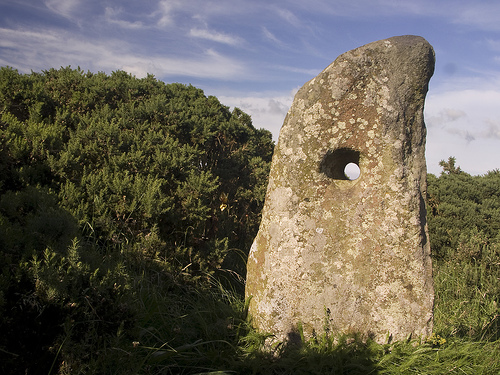The lovely Sharon has been getting a little geeky about maps and things lately, including an interest in the old things in the countryside. So I have made it our mission to go out and check something I have wondered about for a long time. It regards a standing stone that is near-ish to us called the Holestone. It is shocking that we have not yet visited this site at all.
 image by minipixel
image by minipixel
The date and original function of the Holestone is unclear. It may date from pre-Christian times but, unlike two other perforated stones in Co Antrim it has not been ‘christianised’. The Holestone was used at one time to chain up criminals. It has also been used as a betrothal stone, with the happy couple plighting their troth by clasping hands through the stone. Such betrothal ceremonies must have been common in the days of slow travel and shortage of clergy or civic officers. To avoid illegitimacy in children pre-marriage ceremonies were often performed according to local custom; the bond was completed later when a priest or registrar was available. Expressions such as ‘jumping the broomstick’, ‘living over the brush’ or ‘tying the knot’ may come from such ceremonies. (source)
Every since I read “Island of the Setting Sun” I have been curious about the standing stones dotted around the country side. If they were used as calendars then I would love to know the stories told about how to use them and what they line up with. It is very probable that someone has done this with the Holestone but I found very little references on the net, so I decided to give it a try and see if the Holestone is lined up with anything obvious.
A friend, we will call him ‘bad santa’ (you know who you are) told me this morning that he read that the Holestone is lined up exactly with a similar stone in Scotland. Forgive me if I am sceptical of this level of iron age accuracy. I think it is more probable that they are both, independently, aligned with the same astrological feature and therefore appear to line up with each other.
The most obvious thing I thought of was the winter solstice. This is a special occasion in our ancient past as is demonstrated at newgrange.
So I loaded stellarium and wound back the clock to the sunrise on winter solstice 4000 years ago. The result is that from the Holestone’s position and elevation the sun should rise on the winter solstice at about 132 degrees (looking South-East).
Then I read on the internet that the Holestone is actually lined up roughly North-East to South-West. That is not the winter solstice.
The next try is the Summer solstice 4000 year ago. This gives the sunrise to be at a bearing of roughly 048 to 049 degrees (North East).
So my next task is for me to wipe the dust off my sighting compass and convince the lovely Sharon that we need some fresh air. I will get her to look up the magnetic variation on her maps, that will get her hooked.



April 15, 2010 at 5:58 pm
[…] Today I started back into exercise. The end of last term was far too hectic to think of such things and the holidays were…. holidays. But now I have no excuse so I ran to a local standing stone and enjoyed the amazing view. It was not a massive distance but it was worth it as it was the first time I have visited the stone, I just wish I had brought my compass! […]
April 20, 2010 at 9:00 am
Last week I went back to the Holestone and measured the angle. It turns out that I was way off and it does not point to any of the solstices or equinoxes. It points to something more interesting: The High Man – The Giant Hunter